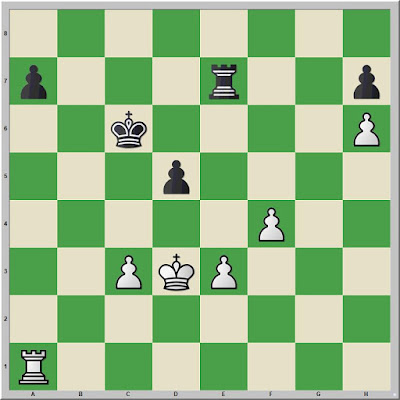White to move
He states that White has a clear advantage. Black "has not very much to do except to mark time and wait for White" (69). He made White's plan seem simple and straightforward. However, when I played it out against the computer the first time, I drew the game. It took several efforts (i.e. takebacks) before I succeeded in defeating the engine.
Capablanca's Analysis
1.Kd4
Black's rook cannot leave the seventh rank without dropping the a-pawn, and leaving the b-file allows White to play b5. Moving the king allows the White king to penetrate to e5, winning the f-pawn.
1...h6 2.f4 Re7 3.b5 Rc7
3...Re4+ 4.Kd3 Rc4 5.bxc3 is given as an alternative, "bringing about very much the same position as in the text" (70). He notes that 5.Rxc6+ would give Black winning chances because of the outside passed pawn.
4.bxc6 Rxc6 5.Rxa7 Rc4+ 6.Kd3 Rc7
White to move
7.Ra8 Rh7 8.Kd4 Ke6 9.Re8
I would be inclined to force the trade of rook and then take the d-pawn with my king.
9...Kd6 10.Rd8 and states the advantage of two pawns should be sufficient to win.
My Practice
First attempt was against Hiarcs on my iPad
1.Kd4 Re7 2.b5 Re4+ 3.Kd3 Kc5
I would reach this position again the next morning against Stockfish 13 on my desktop.
White to move
4.Rxc6 Kxb5 5.Rh6??
Better to fork two pawns with 5.Rc7
5...f4=
This position is completely equal, but I played the game out until it was drawn by repetition on move 81.
I backed that game up to the diagram and captured the pawn with my pawn. Against Stockfish I would try what it recommended in analysis of this effort.
4.bxc6 Re7 5.f4 Kb5 6.c7 Rxc7 7.Rf6 Re7 8.Rxf5 Kc6 9.Rf6+ Kc5 10.Ra6 Kb5 11.Ra1 Kc5 12.h6 Kc6
White to move
 |
| Problem 1 |
It is not easy to find a clear plan from this position.
Against Hiarcs, I played 13.Ra5, and then inexplicably the machine gave me a pawn. 13...a6.
Another morning, I backed the position up a move and played two games against Stockfish 13. Each game required a takeback or two after I blundered into a draw. In the first instance, I maneuvered my rook Ra6-d6-d8, trying to keep pressure on Black's scattered pawns. The second, I thought I would walk my king around to escort the f-pawn, but then brought it back to the center. My takeback came after I played 25.e4 from this position.
White to move
 |
| Problem 2 |
A Better Way
My first effort against Stockfish was informed by the engine's analysis of my battle with Hiarcs.
1.Kd4 Re7 2.b5 Re4+ 3.Kd3 Kc5 4.Rxa7!
The engine's recommendation.
4...cxb5 5.f3+- Rh4
White to move
6.Rxh7 b4 7.cxb4+ Rxb4 8.h6 Rb3+ 9.Kd2 Rb8 10.Rf7 Rb2+ 11.Kc3 Rh2
White to move
12.Rxf5
Giving up one passed pawn for another more useful.
12...Kd6
I anticipated 12...Rxh6 13.e4
Maybe I get to hang on to the h-pawn a little longer.
13.Rf6+ Ke5 14.Ra6 Rh3
White to move
15.f4+ Ke4 16.Re6+ Kf5 17.Re5+ Kf6 18.Kd4
After the exchange of pawns, White's two connected passed pawns should be able to start rolling.
18...Rxh6 19.Rxd5 Rh1 20.Ke4 Re1 21.Rd6
Driving Black's king back.
21...Ke7 22.Ra6 Kf7 23.f5 Rb1 24.Kf4 Rb3 25.e4 Rb4 26.Ke5 Rb5+ 27.Kd4 Rb4+ 28.Kd5 Rb5+ 29.Kc4 30.e5 Rc1+
White to move
Now my king chases the rook.
31.Kd3
The engine suggests 31.Kd5 Rd1+ 32.Kc6 Rc1+ 33.Kd7 as an improvement, as now my rook can shelter my king.
31...Rd1+ 32.Ke2 Rd5 33.Ra7+ Ke8
White to move
I thought I had lost my way again, but after about a minute's calculation saw the solution.
34.Ra8+ Ke7 35.f6+ Kf7 36.Ra7 Kg8 37.Re7
Once again, my rook and pawns are inviolable. My king was able to move forward again, reaching e6. Then the rook shuffled to the d-file to block side checks. After another 13 moves, I had two pawns abreast on the seventh rank. Black drove my king in front of them and I had a queen on move 53.
While Capablanca's explanation makes the basic position seem simple, there is much that can be learned playing such a position against the engine, or even several different engines on different devices.





















No comments:
Post a Comment